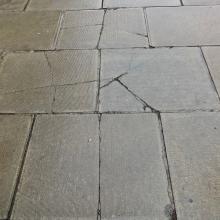
Last month, we reported local concerns about the standard of paving on a section of Leith Walk outside Sainsburys (Breaking news, 29.6.16).
Discontent about the state of our footpaths is not a recent phenomenon, however.
Sections of the following letter, published in the Edinburgh Evening Courant on 26 July 1851, could almost have been written yesterday.
PRINCE’S STREET—FOOT PAVEMENT.
TO THE EDITOR OF THE COURANT.
Duke Street, Thursday, 24th July 1851
SIR—I have read with approbation your correspondent’s—"A Denizen"—letter in this day’s paper, and concur in his opinion that when it has been thought proper to lay pavement even along the dead walls between Clerk Street and the boundary of Police on the south, and alongside the walls of the Coalfaulds on Leith Walk, it is not an hour too soon to get the south side of Prince’s Street paved in a suitable manner.
While thus adverting to new pavement, permit me to notice the old. West Register Street, from the General Register House on the east to St Andrew Square (filled with Banks and Public Offices) on the west, is perhaps one of the greatest thoroughfares for foot passengers in or about this great city. Why, then, let me ask, is the foot-pavement along the street allowed to remain in so disgracefully dilapidated a state as it is, and has for months been?
It is the privilege of the injured to complain. Mr Murray takes good care that I pay him my road-money, and am thus entitled to value. Now, I pass and repass, necessarily, along this thoroughfare twice or thrice every day. Being only a cross street, it is not of extreme width, and the side pavements are proportionally narrow; but why are they not kept whole? Look at them in a dry day, and you see that every third stone is fractured into six or eight pieces! Look again, in a wet day, or rather walk along the pavement then, and you find the remaining stones so worn, as each to contain a dub for you tomarch through plishplashque. This is all the more remarkable, for it contains alongside of it the shops of those very public-spirited individuals who brag of having improved the street at the entrance to East Register Street, with which they have certainly less to do.
Your obedient servant,
ZENAS.
A different correspondent returned to the subject three months later, this time with a deliciously recognisable mixture of New Town special pleading and brown-nosery.
FOOT PAVEMENTS.
TO THE EDITOR OF THE COURANT.
DEAR EDITOR,—We have just had the carriage roadway in North Hanover Street now paved with dressed oblong whin stones, in the most lasting and superior manner. They have also commenced to do the like in North Charlotte Street, and it is exceedingly desirable that it should be extended to every street in Edinburgh. However, whilst this is being done, the side pavements in some of our principal streets and places ought not to be forgotten and overlooked—some of these in in particular should be attended to without delay: I would instance the south side of Prince's Street, from the Waverley Bridge to the Lothian Road, the north side of Queen Street, and the south side in front of Heriot Row—all of which are but rudely paved with undressed whin or gravel, certainly not fit for or becoming the locality of those elegant neighbourhoods, whose footpaths ought to be paved in suitable style, with broad flat freestone flags, like the majority of the other streets in the New Town. It is sincerely to be hoped that this hint will not be lost on our worthy city authorities, so famed for patronizing every rational improvement, and their no less worthy co-adjutors of the Paving Board.
Yours, &c.
L.
October 9, 1851.
------------------
 Rhona Stewart Cameron Nothing changes! The Council still don't listen. Broke my wrist in Dundas Street last year. Perhaps i should write an epistle too to be read in 165 years and I bet still nothing has changed.
Rhona Stewart Cameron Nothing changes! The Council still don't listen. Broke my wrist in Dundas Street last year. Perhaps i should write an epistle too to be read in 165 years and I bet still nothing has changed.